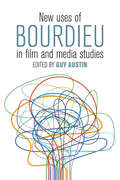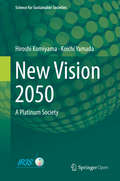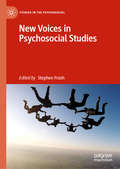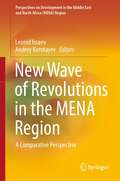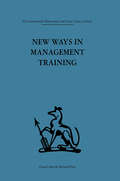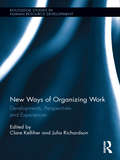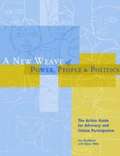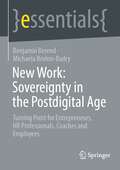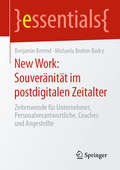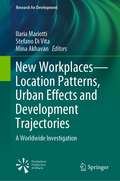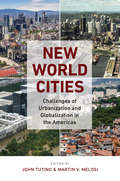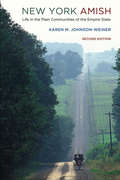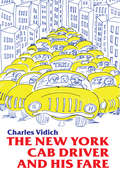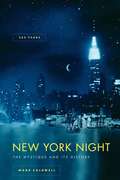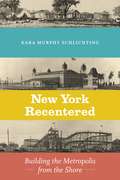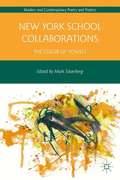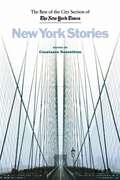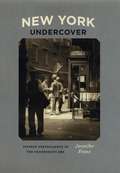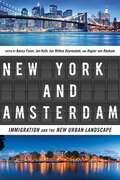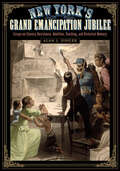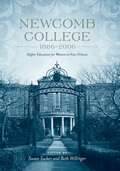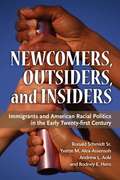- Table View
- List View
New Urban Management: Attracting Value Flows to Branded Hubs
by Ari-Veikko AnttiroikoNew Urban Management discusses how the logic of economic flows poses a challenge to local governments throughout the world. The book argues that the increased fluidity in economic life must have its reflection in local economic development policy.
New Uses of Bourdieu in Film and Media Studies
by Guy AustinThrough his influential work on cultural capital and social mobility, the French sociologist Pierre Bourdieu has provided critical insights into the complex interactions of power, class, and culture in the modern era. Ubiquitous though Bourdieu's theories are, however, they have only intermittently been used to study some of the most important forms of cultural production today: cinema and new media. With topics ranging from film festivals and photography to constantly evolving mobile technologies, this collection of essays demonstrates the enormous relevance that Bourdieu's key concepts hold for the field of media studies, deploying them as powerful tools of analysis and forging new avenues of inquiry in the process.
New Vision 2050: A Platinum Society (Science For Sustainable Societies Ser.)
by Hiroshi Komiyama Koichi YamadaThis book presents the "New Vision 2050," which adds the concept of the “platinum society” to the “Vision 2050”.The 20th century was a century in which energy led the development of material civilization, resulting in deletion of resources, global warming and climate change. What form should sustainable material and energy take to protect the Earth? The "Vision 2050" was established 20 years ago as a model that we should pursue for the next half century. Fortunately, the world is on course for the Vision 2050.The 21st century will be a century in which we seek qualitative richness, with the Vision 2050 as the material basis. That is, a “platinum society” that has resource self-sufficiency and resource symbiosis, and where people remain active throughout their lives and have a wide range of choices and opportunities for free participation. Since the author presented the concept of "Vision 2050" in 1999, the idea has been introduced in two books entitled Vision 2050: Roadmap for a Sustainable Earth (2008) and Beyond the Limits to Growth: New Ideas for Sustainability from Japan (2014). The latter includes a chapter that sheds light on the concept of a “platinum society”. In this publication, the author presents the "New Vision 2050" in more detail.
New Voices in Psychosocial Studies (Studies in the Psychosocial)
by Stephen FroshPsychosocial studies in the UK is a diverse area of work characterised by innovation in theory and empirical research. Its extraordinary liveliness is demonstrated in this book, which showcases research undertaken at the Department of Psychosocial Studies at Birkbeck, University of London, UK, highlighting three domains central to the discipline – psychoanalysis, ethics and reflexivity, and resistance. The book engages psychosocially with a wide variety of topics, from social critiques of psychoanalysis through postcolonial and queer theory to studies of mental health and resistance to discrimination. These ‘New Voices in Psychosocial Studies’ offer a coherent yet wide-ranging account of research that has taken place in one ‘dialect’ of the new terrain of psychosocial studies and an agenda-setting manifesto for some of the kinds of work that might ensure the continued creativity of psychosocial studies into the next generation. This book demonstrates the ongoing development of psychosocial studies as an innovative, critical force and will inspire both new and established researchers from across the fields that influence its transdisciplinary approach, including: critical psychology and radical sociology, feminist, queer and postcolonial theory, critical anthropology and ethnography and phenomenology.
New Wave of Revolutions in the MENA Region: A Comparative Perspective (Perspectives on Development in the Middle East and North Africa (MENA) Region)
by Andrey Korotayev Leonid IssaevThis book offers a comparative perspective on the new wave of revolutions in the MENA region. Recently, a new wave of revolutions has swept the Middle East and North Africa (MENA) region, comparable in some respects to the events of the Arab Spring. Revolutionary events have significantly changed the political regimes in Sudan, Algeria and Mali, while Lebanon and Iraq have also witnessed serious revolutionary episodes. Further, a new quality of protests has manifested in Iran, Egypt, Morocco and Jordan. Presenting a variety of country studies, this book identifies similarities and differences between the events of the Arab Spring and the current upheavals in the MENA region and examines their causes and world-system context. It also analyzes the motivating forces, goals and organizational forms of the protesters and other actors involved, as well as the political and economic consequences of these revolutionary events. Moreover, it seeks to understand why some countries that were actively involved in the Arab Spring have remained largely unaffected by these developments. The book appeals to scholars of political science with a focus on comparative politics, Middle Eastern politics and political sociology.
New Ways in Management Training: A technical college develops its services to industry
by Cyril Sofer Geoffrey HuttonTavistock Press was established as a co-operative venture between the Tavistock Institute and Routledge & Kegan Paul (RKP) in the 1950s to produce a series of major contributions across the social sciences. This volume is part of a 2001 reissue of a selection of those important works which have since gone out of print, or are difficult to locate. Published by Routledge, 112 volumes in total are being brought together under the name The International Behavioural and Social Sciences Library: Classics from the Tavistock Press. Reproduced here in facsimile, this volume was originally published in 1958 and is available individually. The collection is also available in a number of themed mini-sets of between 5 and 13 volumes, or as a complete collection.
New Ways of Organizing Work: Developments, Perspectives, and Experiences (Routledge Studies in Human Resource Development)
by Clare Kelliher Julia RichardsonNew Ways of Organizing Work offers a broader understanding of changes to the way work is organized and the implications for relevant stakeholders. It brings together contributions from a well established group of international scholars to examine the nature and consequences of new ways of working. The book draws on studies of a variety of new forms of work, involving a diverse range of employees and drawing on experiences in a variety of countries. It includes three main empirical sections. The first focuses on different forms of work and working arrangements, stimulated by the use of technology, increased competitive pressure and media portrayal of work and working. In contrast to much other work in the field, a strong theme of this book is individuals’ experiences of new ways of working. The second empirical section examines this theme with a specific focus on remote workers and their responses to new ways of working. Exploring contemporary trends towards increasing use of global teams, the third section examines the implications of distributed teams and the challenges for managing performance and knowledge transfer.
New Weave of Power, People and Politics: The Action Guide for Advocacy and Citizen Participation
by Lisa Veneklasen Valerie MillerA practical handbook for activists, grassroots, and advocacy groups · Covers constituency building and the theory behind the practice · "a significant contribution to the growing international literature on citizen participation and advocacy A New Weave has been needed for a long time. "--John Gaventa, Institute of Development Studies. This book breaks down the boxes separating human rights, rule of law, development, and governance, and creates an integrated approach to rights-based political empowerment. It combines concrete and practical action 'steps' with a sound theoretical foundation to help users understand the process of advocacy planning and implementation. Building on the authors' fifty years of combined experiences in advocacy, gender, human rights, education, and social change, this "action guide" gathers insights from across the world--including community development, legal rights education, and campaign advocacy. It includes a special training and capacity-building appendix that provides workshop and planning ideas for different users and needs.
New Work: Turning Point for Entrepreneurs, HR Professionals, Coaches and Employees (essentials)
by Benjamin Berend Michaela Brohm-BadryThe essential introduces the New Work idea, the core of which is to pursue work that one "really, really wants". This approach is updated with regard to the three areas of individual, organization and society. Special consideration is given to findings from positive psychology and strength-oriented organizational research. With reference to examples and scientific findings, innovative working time models, organizational forms and management practices are presented. Finally, New Work is discussed in the context of progressive social ideas such as basic income, breathing life courses and post-growth.
New Work: Zeitenwende für Unternehmer, Personalverantwortliche, Coaches und Angestellte (essentials)
by Benjamin Berend Michaela Brohm-BadryDas essential führt in die New-Work-Idee ein, deren Kern es ist, einer Arbeit nachzugehen, die man „wirklich, wirklich will“. Dieser Ansatz wird im Hinblick auf die drei Bereiche Individuum, Organisation und Gesellschaft aktualisiert. Besondere Berücksichtigung finden dabei Befunde aus der Positiven Psychologie und der stärkenorientierten Organisationsforschung. Unter Bezugnahme auf Beispiele und wissenschaftliche Befunde werden innovative Arbeitszeitmodelle, Organisationsformen und Managementpraktiken vorgestellt. Schließlich wird New Work im Kontext progressiver gesellschaftlicher Ideen wie Grundeinkommen, Atmende Lebensläufe und Postwachstum diskutiert.
New Workplaces—Location Patterns, Urban Effects and Development Trajectories: A Worldwide Investigation (Research for Development)
by Ilaria Mariotti Stefano Di Vita Mina AkhavanThis book explores the innovative workplaces, namely coworking spaces and makerspaces, that are emerging as a consequence of digital innovations and the related development of the knowledge economy and society in the wake of deindustrialization. Drawing on international and multidisciplinary research projects, fresh insights are provided into current trends, research methodologies, actors, location patterns and effects, and urban and regional policies and planning. The aim is to cast light on all aspects of these new working and making spaces, highlighting their innovative geographies and the complexities of their nexus with urban and regional change processes from both the theoretical and the empirical point of view. The book includes multiple illuminating case studies from the advanced economies of North America and Europe, carefully selected for their relevance to the topic under analysis. This book is designed for an international audience comprising not only academicians but also policymakers, representatives of civil and entrepreneurial associations, and business operators.
New World Cities: Challenges of Urbanization and Globalization in the Americas
by John Tutino and Martin V. MelosiFor millennia, urban centers were pivots of power and trade that ruled and linked rural majorities. After 1950, explosive urbanization led to unprecedented urban majorities around the world. That transformation--inextricably tied to rising globalization--changed almost everything for nearly everybody: production, politics, and daily lives. In this book, seven eminent scholars look at the similar but nevertheless divergent courses taken by Mexico City, Rio de Janeiro, Buenos Aires, Montreal, Los Angeles, and Houston in the twentieth century, attending to the challenges of rapid growth, the gains and limits of popular politics, and the profound local effects of a swiftly modernizing, globalizing economy. By exploring the rise of these six cities across five nations, New World Cities investigates the complexities of power and prosperity, difficulty and desperation, while reckoning with the social, cultural, and ethnic dynamics that mark all metropolitan areas.Contributors: Michele Dagenais, Mark Healey, Martin V. Melosi, Bryan McCann, Joseph A. Pratt, George J. Sanchez, and John Tutino.
New World Gold: Cultural Anxiety and Monetary Disorder in Early Modern Spain
by Elvira VilchesThe discovery of the New World was initially a cause for celebration. But the vast amounts of gold that Columbus and other explorers claimed from these lands altered Spanish society. The influx of such wealth contributed to the expansion of the Spanish empire, but also it raised doubts and insecurities about the meaning and function of money, the ideals of court and civility, and the structure of commerce and credit. New World Goldshows that, far from being a stabilizing force, the flow of gold from the Americas created anxieties among Spaniards and shaped a host of distinct behaviors, cultural practices, and intellectual pursuits on both sides of the Atlantic. Elvira Vilches examines economic treatises, stories of travel and conquest, moralist writings, fiction, poetry, and drama to reveal that New World gold ultimately became a problematic source of power that destabilized Spain’s sense of trust, truth, and worth. These cultural anxieties, she argues, rendered the discovery of gold paradoxically disastrous for Spanish society. Combining economic thought, social history, and literary theory in trans-Atlantic contexts,New World Goldunveils the dark side of Spain’s Golden Age.
New York Amish: Life in the Plain Communities of the Empire State
by Karen M. Johnson-WeinerIn a book that highlights the existence and diversity of Amish communities in New York State, Karen M. Johnson-Weiner draws on twenty-five years of observation, participation, interviews, and archival research to emphasize the contribution of the Amish to the state's rich cultural heritage. While the Amish settlements in Pennsylvania and Ohio are internationally known, the Amish population in New York, the result of internal migration from those more established settlements, is more fragmentary and less visible to all but their nearest non-Amish neighbors. All of the Amish currently living in New York are post–World War II migrants from points to the south and west. Many came seeking cheap land, others as a result of schism in their home communities. The Old Order Amish of New York are relative newcomers who, while representing an old or plain way of life, are bringing change to the state. So that readers can better understand where the Amish come from and their relationship to other Christian groups, New York Amish traces the origins of the Amish in the religious confrontation and political upheaval of the Protestant Reformation and describes contemporary Amish lifestyles and religious practices. Johnson-Weiner welcomes readers into the lives of Amish families in different regions of New York State, including the oldest New York Amish community, the settlement in the Conewango Valley, and the diverse settlements of the Mohawk Valley and the St. Lawrence River Valley. The congregations in these regions range from the most conservative to the most progressive. Johnson-Weiner reveals how the Amish in particular regions of New York realize their core values in different ways; these variations shape not only their adjustment to new environments but also the ways in which townships and counties accommodate—and often benefit from—the presence of these thriving faith communities.
New York Cab Driver and His Fare
by Charles VidichUsing information derived from research and interviews with cab drivers, Vidich has written a basic work on New York City cab drivers (hacks) that also provides passengers (fares) with a survival manual. Cab drivers are quoted by newspaper columnists, politicians, and at dinner parties; yet a hard look at the profession and its role in the transportation system of the city has been completely lacking. Vidich brings out in clear language the conflicts between the cab driver's position as a dispenser of a public service and his needs as a working person subjected to violence and pressure. It is difficult to imagine a more enjoyable introduction to an industry whose members are a folk tradition. At the same time, this book provides insight into the history and sociology of an important urban institution. It is a book about cab drivers everywhere; and cab drivers and fares in all cities have a new handbook in this volume.
New York Night
by Mark CaldwellWho among us cannot testify to the possibilities of the night? To the mysterious, shadowed intersections of music, smoke, money, alcohol, desire, and dream? The hours between dusk and dawn are when we are most urgently free, when high meets low, when tongues wag, when wallets loosen, when uptown, downtown, rich, poor, black, white, gay, straight, male, and female so often chance upon one another. Night is when we are more likely to carouse, fornicate, fall in love, murder, or ourselves fall prey. And if there is one place where the grandness, danger, and enchantment of night have been lived more than anywhere else -- lived in fact for over 350 years -- it is, of course, New York City. From glittering opulence to sordid violence, from sweetest romance to grinding lust, critic and historian Mark Caldwell chronicles, with both intimate detail and epic sweep, the story of New York nightlife from 1643 to the present, featuring the famous, the notorious, and the unknown who have long walked the city's streets and lived its history. New York Night ranges from the leafy forests at Manhattan's tip, where Indians and Europeans first met, to the candlelit taverns of old New Amsterdam, to the theaters, brothels, and saloon prizefights of the Civil War era, to the lavish entertainments of the Gilded Age, to the speakeasies and nightclubs of the century past, and even to the strip clubs and glamour restaurants of today. We see madams and boxers, murderers and drunks, soldiers, singers, layabouts, and thieves. We see the swaggering "Sporting Men,"the fearless slatterns, the socially prominent rakes, the chorus girls, the impresarios, the gangsters, the club hoppers, and the dead. We see none other than the great Charles Dickens himself taken to a tavern of outrageous repute and be so shocked by what he witnesses that he must be helped to the door. We see human beings making their nighttime bet with New York City. Some of these stories are tragic, some comic, but all paint a resilient metropolis of the night. In New York, uniquely among the world's great cities, the hours of darkness have always brought opposites together, with results both creative and violent. This is a book that is filled with intrigue, crime, sex, violence, music, dance, and the blur of neon-lit crowds along ribbons of pavement. Technology, too, figures in the drama, with such inventions as gas and electric light, photography, rapid transit, and the scratchy magic of radio appearing one by one to collaborate in a nocturnal world of inexhaustible variety and excitement. New York Night will delight history buffs, New Yorkers in love with their home, and anyone who wants to see how human nocturnal behavior has changed and not changed as the world's greatest city has come into being. New York Night is a spellbinding social history of the day's dark hours, when work ends, secrets reveal themselves, and the unimaginable becomes real.
New York Recentered: Building the Metropolis from the Shore (Historical Studies of Urban America)
by Kara Murphy SchlichtingThe history of New York City’s urban development often centers on titanic municipal figures like Robert Moses and on prominent inner Manhattan sites like Central Park. New York Recentered boldly shifts the focus to the city’s geographic edges—the coastlines and waterways—and to the small-time unelected locals who quietly shaped the modern city. Kara Murphy Schlichting details how the vernacular planning done by small businessmen and real estate operators, performed independently of large scale governmental efforts, refigured marginal locales like Flushing Meadows and the shores of Long Island Sound and the East River in the late nineteenth and early twentieth centuries. The result is a synthesis of planning history, environmental history, and urban history that recasts the story of New York as we know it.
New York School Collaborations
by Mark SilverbergRanging from conceptual theater to visual poetry the New York School explored the possibilities of collaboration like no other group of American poets. New York School Collaborations gathers essays from a diverse group of scholars on the alliances and artistic co-productions of New York School poets, painters, musicians, and film-makers.
New York Stories: The Best of the City Section of the New York Times
by Constance RosenblumThese forty essays from the New York Times&’ City section tell &“stories of human life in all its quirky richness&” (The Boston Globe). Featuring a cast of stellar writers, this collection brings some of the best essays from the City section to readers beyond the five boroughs. New York Stories profiles people like sixteen-year-old Barbara Ott, who surfs the waters off Rockaway in Queens, and Sonny Payne, the beloved panhandler of the F train. Other essays explore memorable places, from the Greenwich Village townhouse blown up by radical activists in the 1970s to a basketball court that serves as the heart of its Downtown neighborhood. The forty essays collected here reflect an intimate understanding of the city, one that goes beyond the headlines. The result is a passionate, well-written portrait of a legendary and ever-evolving place. Contributors include: Andre Aciman, Thomas Beller, Laura Shaine Cunningham, Jim Dwyer, Jill Eisenstadt, Vivian Gornick, Chuck Klosterman, Robert Lipsyte, Phillip Lopate, Jan Morris, Richard Price, Joe Queenan, Suzanne Vega, Meg Wolitzer, and more &“Unassuming, elegant dispatches, suffused with a wise but unsentimental affection.&”—The New Yorker &“All of the pieces are engrossing . . . This is both an excellent addition to New York history and a pleasure for casual browsing.&” ―Publishers Weekly
New York Undercover: Private Surveillance In The Progressive Era (Historical Studies Of Urban America Ser.)
by Jennifer FroncTo combat behavior they viewed as sexually promiscuous, politically undesirable, or downright criminal, social activists in Progressive-era New York employed private investigators to uncover the roots of society’s problems. New York Undercover follows these investigators—often journalists or social workers with no training in surveillance—on their information-gathering visits to gambling parlors, brothels, and meetings of criminal gangs and radical political organizations. <P><P> Drawing on the hundreds of detailed reports that resulted from these missions, Jennifer Fronc reconstructs the process by which organizations like the National Civic Federation and the Committee of Fourteen generated the knowledge they needed to change urban conditions. <P><P>This information, Fronc demonstrates, eventually empowered government regulators in the Progressive era and beyond, strengthening a federal state that grew increasingly repressive in the interest of pursuing a national security agenda. Revealing the central role of undercover investigation in both social change and the constitution of political authority, New York Undercover narrates previously untold chapters in the history of vice and the emergence of the modern surveillance state.
New York Underground: The Anatomy of a City
by Julia SolisDid alligators ever really live in New York's sewers? What's it like to explore the old aqueducts beneath the city? How many levels are beneath Grand Central Station? And how exactly did the pneumatic tube system that New York's post offices used to employ work?In this richly illustrated historical tour of New York's vast underground systems, Julia Solis answers all these questions and much, much more. New York Underground takes readers through ingenious criminal escape routes, abandoned subway stations, and dark crypts beneath lower Manhattan to expose the city's basic anatomy. While the city is justly famous for what lies above ground, its underground passages are equally legendary and tell us just as much about how the city works.
New York and Amsterdam: Immigration and the New Urban Landscape
by Nancy Foner Jan Willem Duyvendak Jan Rath Rogier van ReekumA thought-provoking essay collection exploring the effects of extensive immigration on heavily populated urban centers. Immigration is dramatically changing major cities throughout the world. Nowhere is this more so than in New York City and Amsterdam, which, after decades of large-scale immigration, now have populations that are more than a third foreign-born. These cities have had to deal with the challenge of incorporating hundreds of thousands of immigrants whose cultures, languages, religions, and racial backgrounds differ dramatically from those of many long-established residents. New York and Amsterdam brings together a distinguished and interdisciplinary group of American and Dutch scholars to examine and compare the impact of immigration on two of the world&’s largest urban centers. The original essays in this volume discuss how immigration has affected social, political, and economic structures, cultural patterns, and intergroup relations in the two cities, investigating how the particular, and changing, urban contexts of New York City and Amsterdam have shaped immigrant and second generation experiences. Despite many parallels between New York and Amsterdam, the differences stand out, and juxtaposing essays on immigration in the two cities helps to illuminate the essential issues that today&’s immigrants and their children confront. Organized around five main themes, this book offers an in-depth view of the impact of immigration as it affects particular places, with specific histories, institutions, and immigrant populations. New York and Amsterdam profoundly contributes to our broader understanding of the transformations wrought by immigration and the dynamics of urban change, providing new insights into how—and why—immigration&’s effects differ on the two sides of the Atlantic.
New York's Grand Emancipation Jubilee: Essays on Slavery, Resistance, Abolition, Teaching, and Historical Memory
by Alan J. SingerIn this book Alan J. Singer discusses the history of race and racism in the United States, emphasizing the continuing significance of slavery's past in shaping our present. Each chapter addresses a different theme in the history of slavery and the abolitionist struggle in the United States, with a focus on events and debates in New York State. Chapters examine the founders of the new nation and their views on slavery and equality; African American resistance; how abolitionists moved from the margins to the center of political debate; key players in the anti-slavery struggle such as David Ruggles, Solomon Northup, Harriet Tubman, Frederick Douglass, William Seward, and Abraham Lincoln; celebrations of freedom; as well as ongoing racism. Interspersed throughout the text are teaching notes that explore primary source documents and resources. The book draws on the latest scholarship to address and correct historical myths about both New York State before, during, and after the American Civil War, especially the pro-slavery, anti-civil rights stance of New York Copperhead Democrats in Congress, and the crucial role of Black and White abolitionists in ending slavery in the United States and challenging racial injustice. New York's Grand Emancipation Jubilee is not only an effort to include more African Americans as historical actors and celebrate their activism and achievements, but to provide an opportunity to analyze historical moments for change, explore their dynamic, and discover the conditions that make some of them successful.
Newcomb College, 1886-2006: Higher Education for Women in New Orleans
by Susan Tucker Beth WillingerIn 1886, Josephine Louise Newcomb donated funds to Tulane University for the founding of the H. Sophie Newcomb Memorial College. Her contribution created the nation's first degree-granting coordinate college for women. For more than a century, Newcomb College educated thousands of young women in the liberal arts and sciences, preparing them for positions in the civic and economic world of New Orleans and the South. Newcomb College, 1886--2006 explores the rich history and tradition of the college through a diverse and multidisciplinary collection of essays. Early chapters focus on the life of Josephine Louise Newcomb and her desire to memorialize her daughter Sophie, as well as the development of student culture in the Progressive Era. Several essays explore the staples of a Newcomb education, from its acclaimed pottery and junior year abroad programs to lesser-known but trailblazing work in physical education and chemistry. Concluding biographical and autobiographical chapters recount the lives of distinguished alumnae and the personal memories of Newcomb's influence on New Orleans. The essays offer insight into the work of artists Caroline Wogan Durieux and Ida Kohlmeyer, education reformer Sarah Towles Reed, U.S. representative Lindy Boggs, and other Newcomb leaders in various fields. Throughout the book, contributors reflect on the curriculum, pedagogy, and alliances that created paths for students, not only for advanced studies, but also for their roles as friends, wives, mothers, reformers, and professionals. Touching on three centuries, the book concludes in 2006 when Tulane University closed Newcomb College and Paul Tulane College, the arts and sciences college for men, and united the two as Newcomb-Tulane College. This absorbing collection offers both a scholarly history and an affectionate tribute to a Newcomb education.
Newcomers, Outsiders and Insiders: Immigrants and American Racial Politics in the Early Twenty-first Century
by Rodney E. Hero Ronald Schmidt Andrew L. Aoki Yvette M. Alex-Assensoh"The authors have done a commendable and impressive job of addressing a topic of long-lasting and increasing significance in U. S. politics. " ---F. Chris Garcia, University of New Mexico "This is a path-breaking book that will be read across disciplines beyond political science. " ---James Jennings, Tufts University Over the past four decades, the United States has experienced the largest influx of immigrants in its history. Not only has the ratio of European to non-European newcomers changed, but recent arrivals are coming from the Asian subcontinent, Southeast Asia, South America, and other regions which have not previously supplied many immigrants to the United States. In this timely study, a team of political scientists examines how the arrival of these newcomers has affected the efforts of long-standing minority groups---Blacks, Latinos, and Asian Pacific Americans---to gain equality through greater political representation and power. The authors predict that, for some time to come, the United States will function as a complex multiracial hierarchy, rather than as a genuine democracy. Ronald Schmidt, Sr. is Professor of Political Science at California State University, Long Beach. Yvette M. Alex-Assensoh is Associate Professor of Political Science and Dean of the Office for Women's Affairs (OWA) at Indiana University, Bloomington. Andrew L. Aoki is Professor of Political Science at Augsburg College. Rodney E. Hero is the Packey J. Dee Professor of American Democracy at the University of Notre Dame.

